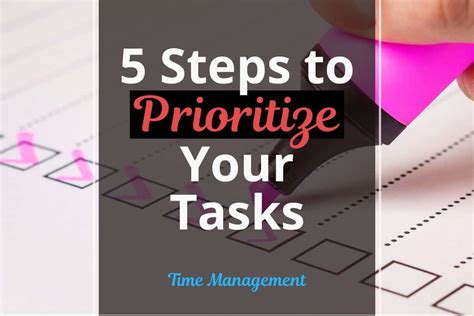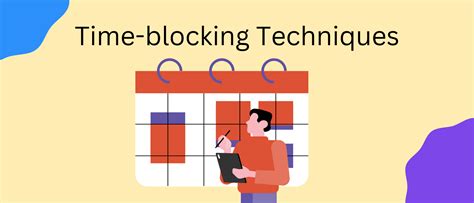In today's fast-paced and demanding world, finding the perfect balance between work and personal life can often feel like an unattainable goal. We all strive to accomplish more in less time and to excel in every aspect of our lives. However, the key to achieving this lies not in working longer hours, but rather in managing our time effectively. By mastering the art of time management, we can increase productivity, reduce stress, and create more space for the things that truly matter.
Time is a precious resource that must be cherished and utilized wisely. However, we often find ourselves losing track of it and succumbing to distractions that hinder our progress. This is where effective time management steps in, empowering us to take control of our days and make the most out of our limited time. From setting clear goals and setting priorities to avoiding procrastination and making use of tools and techniques, there are various strategies that can transform our hectic schedule into a well-organized, efficient routine.
Embracing effective time management techniques not only allows us to accomplish more tasks within a given timeframe but also enhances the quality of our work. It enables us to focus on the most important and meaningful activities, ensuring that our efforts are aligned with our goals and values. By eliminating unnecessary distractions and streamlining our workflow, we can enhance our focus, creativity, and efficiency. The result? Increased productivity, improved job satisfaction, and a better work-life balance.
Prioritize Your Tasks: A Key to Efficient Time Management

When it comes to managing your time effectively and maximizing productivity, one crucial aspect is prioritizing your tasks. Prioritization plays a fundamental role in ensuring that you focus on the most important and urgent tasks, allowing you to complete them efficiently and without unnecessary stress.
In order to prioritize effectively, it is essential to have a clear understanding of your goals and objectives. By identifying what is truly important to you and aligning your tasks accordingly, you can ensure that your time and efforts are channeled towards the most impactful activities.
- Start by categorizing your tasks based on urgency and importance. This can be done through a simple classification system such as a priority matrix or a to-do list. Assigning priority levels to your tasks will allow you to quickly identify what needs to be addressed first.
- Analyze the consequences of not completing certain tasks in a timely manner. By understanding the potential impacts and consequences, you can make informed decisions about which tasks require immediate attention.
- Consider the estimated time and effort required for each task. Some tasks may appear important, but if they are overly time-consuming and do not provide significant value, they may be better suited for delegation or postponement.
- Flexibility is important when prioritizing tasks. Unexpected situations and new priorities may arise, requiring you to adapt your plans accordingly. Being able to reprioritize efficiently and adjust your focus will help you maintain productivity even in the face of unforeseen changes.
Remember, effective time management is not about working harder, but rather about working smarter. By prioritizing your tasks, you can ensure that you invest your time and energy in the most impactful activities, leading to increased efficiency, productivity, and ultimately, success.
Set Realistic Goals: Maximizing Your Time's Potential
When it comes to optimizing your productivity and making the most of your available time, setting realistic goals is a key strategy. By defining clear and attainable objectives, you can effectively manage your time, stay focused, and accomplish more in less time.
1. Prioritize your tasks: Begin by identifying the most important tasks that need to be completed. This will help you establish a clear focus and allocate your time accordingly. Remember to consider deadlines and the impact of each task on your overall goals.
2. Break it down: Large projects or tasks can quickly become overwhelming, leading to inefficiency and procrastination. Break down larger tasks into smaller, more manageable steps. This will not only make the task seem less daunting but also provide a sense of progress as you tick off each completed step.
- Assign deadlines: Set realistic deadlines for each step to ensure that you remain on track. This will help you maintain a steady pace of progress and avoid last-minute rushes.
- Use time-blocking: Allocate dedicated time blocks for different tasks or activities. By sticking to a schedule, you can avoid distractions and optimize your focus and productivity.
- Stay flexible: While it is important to set goals and create a plan, be prepared to adapt and adjust as needed. Life is unpredictable, and unexpected events or changes may require you to revise your goals or timelines.
3. Celebrate milestones: Recognize and celebrate your achievements along the way. Accomplishing smaller goals not only boosts motivation but also allows you to evaluate your progress and make any necessary adjustments to your approach.
4. Track and analyze: Keep a record of your time spent on various tasks and activities to identify patterns and areas for improvement. This will help you identify time-wasting activities and make informed decisions on how to better allocate your time in the future.
By setting realistic goals and effectively managing your time, you can enhance your productivity and make the most of every moment. Remember, it's not just about working harder but also working smarter.
Master the Art of Delegation: Learn to Share Your Workload

In the realm of efficient time utilization, acquiring the skill of delegation can significantly enhance your productivity. Delegation entails entrusting specific tasks to others, thereby freeing up your own time and focusing on more crucial responsibilities. By harnessing the power of delegation, you can effectively collaborate with your team, optimize work distribution, and maximize overall efficiency.
One essential aspect of mastering the art of delegation is recognizing the importance of effective communication. Clearly articulating your expectations, desired outcomes, and specific instructions to your team members is vital for fostering a successful delegation process. By utilizing strong and concise communication skills, you can ensure that tasks are carried out efficiently and align with your overall objectives.
Delegation also involves identifying the strengths and weaknesses of your team members. Understanding their individual capabilities enables you to assign tasks that align with their skill sets, boosting their motivation and overall performance. By matching tasks to the right individuals, you can promote a sense of empowerment and ownership, leading to higher productivity and job satisfaction.
Furthermore, delegation allows you to capitalize on the concept of collaboration. By involving your team in decision-making processes and encouraging their input, you foster a culture of shared responsibility and ownership. This not only reduces your workload but also enhances creativity and innovation within the team, enabling them to contribute their unique perspectives and ideas.
Delegation empowers you to prioritize your time effectively and focus on tasks that require your expertise and attention. By redistributing workload to capable team members, you can increase productivity, meet deadlines more efficiently, and achieve better overall results. Remember, effective delegation is not about relinquishing control, but rather about utilizing the strengths of your team to accomplish goals more efficiently.
In conclusion, mastering the art of delegation is instrumental in optimizing time management and boosting productivity. By understanding the importance of effective communication, leveraging individual strengths, encouraging collaboration, and prioritizing tasks, you can successfully share your workload and achieve remarkable outcomes.
Avoid Procrastination: Take Control of Your Time
In order to maximize productivity and make the most efficient use of your time, it is important to combat the habit of procrastination. By taking control of your time and avoiding procrastination, you can increase focus, reduce stress, and achieve your goals more effectively.
- Break tasks into smaller, manageable steps: Dividing complex tasks into smaller, more achievable steps can help alleviate the overwhelming feeling that often leads to procrastination. By focusing on one step at a time, you can work towards your larger goals without feeling daunted.
- Set realistic deadlines and stick to them: Establishing clear, realistic deadlines for tasks can create a sense of urgency and help keep procrastination at bay. However, it is crucial to ensure that the deadlines you set are achievable to avoid feeling overwhelmed and giving in to procrastination.
- Prioritize tasks and create a schedule: Prioritizing tasks based on importance and urgency can help you allocate your time efficiently. By creating a schedule and sticking to it, you can ensure that essential tasks are completed in a timely manner, reducing the temptation to procrastinate.
- Eliminate distractions: Identify and minimize potential distractions that may hinder your productivity and lead to procrastination. This could include turning off notifications on your phone or computer, finding a quiet workspace, or using productivity apps or tools to stay focused.
- Practice effective time management techniques: Discover and implement time management techniques that work best for you. This could involve utilizing the Pomodoro Technique, where you divide your work into distinct time intervals, or adopting the Eisenhower Matrix to prioritize tasks based on their importance and urgency.
- Overcome perfectionism and fear of failure: Procrastination often stems from a fear of failure or the desire for perfection. Accept that mistakes and imperfections are a part of the learning process, and focus on progress rather than aiming for perfection. By embracing a growth mindset, you can overcome procrastination and move forward with your tasks.
- Seek accountability and support: Consider finding an accountability partner or joining a productivity group to hold yourself accountable for your time management goals. Collaborating with like-minded individuals can provide support, encouragement, and motivation to stay on track and avoid procrastination.
By implementing these strategies and developing effective time management habits, you can take control of your time and minimize the tendency to procrastinate. Remember, successful time management is crucial for boosting productivity and achieving your goals.
Master the Time-blocking Technique: A Powerful Strategy for Enhanced Efficiency

In today's fast-paced world, maximizing productivity is crucial for achieving success in both personal and professional endeavors. One effective strategy to accomplish this is the utilization of the time-blocking technique. By embracing this innovative approach, individuals can enhance their focus, prioritize tasks, and make the most out of their valuable time.
Understanding the concept: The time-blocking technique involves allocating specific time slots for various activities, allowing individuals to systematically manage their tasks. Instead of approaching tasks haphazardly, this strategy encourages individuals to proactively plan their day, ensuring essential activities receive the attention they deserve.
Advantages of time-blocking: Harnessing the power of time-blocking brings numerous benefits. It enables individuals to eliminate multitasking, a common productivity killer, and instead concentrate on one task at a time. By dedicating undivided attention to each activity, individuals can complete tasks more efficiently and produce higher quality work.
Furthermore, time-blocking empowers individuals to prioritize their tasks effectively. By assigned specific time slots for essential activities such as important meetings, focused work sessions, or personal breaks, individuals can ensure they are addressing their top priorities and maintaining a healthy work-life balance.
Implementing the technique: To effectively implement the time-blocking technique, begin by identifying your most important tasks and allocating specific time slots for each. It is crucial to be realistic about the time required for each task and allow for adequate breaks to recharge your energy and maintain focus.
Additionally, it can be helpful to categorize tasks by their nature, such as administrative, creative, or strategic, and assign appropriate time blocks accordingly. This approach allows for better workflow management and ensures tasks of similar types are grouped together for optimal efficiency.
Conclusion: The time-blocking technique is a powerful strategy that empowers individuals to take control of their time and boost productivity. By adopting this methodology, individuals can effectively manage their tasks, eliminate distractions, and accomplish their goals with greater ease and efficiency.
Minimize Distractions: Stay Focused and Save Time
In order to enhance efficiency and make the most of your valuable time, it is crucial to minimize distractions and maintain a focused mindset. By reducing interruptions and staying on task, you can effectively save time and increase productivity.
When striving for optimal time utilization, it is essential to recognize the various distractions that can hinder your progress. These potential disruptions can range from external factors such as noise or frequent interruptions from colleagues, to internal factors such as personal thoughts or impulses to check social media. It is important to identify these distractions and find strategies to tackle them head-on.
One effective approach to minimizing distractions is creating a clutter-free workspace. Ensure that your environment is organized and devoid of unnecessary items that may divert your attention. Establishing clear boundaries with your coworkers, such as signaling times when you prefer not to be disturbed, can also contribute to a more focused work ambiance.
Another valuable tactic is setting specific time blocks for focused work. By dedicating uninterrupted periods solely to your most important tasks, you can maintain concentration and avoid the temptation of succumbing to distractions. Prioritize the completion of essential assignments during these focused sessions to ensure that your valuable time is well-spent.
Moreover, it is beneficial to utilize technology wisely to minimize distractions. While technological devices can be valuable tools for productivity, they can also be sources of diversion. Consider disabling notifications or using apps that block distracting websites or apps during your designated work periods. By taking control of technological disruptions, you can effectively enhance your focus and save significant amounts of time.
Lastly, it is essential to recognize the power of mindset in minimizing distractions. Adopt a proactive approach and develop self-discipline to resist the urge of distractions. Engage in practices such as mindfulness or meditation to train your mind to remain present and focused on the task at hand. By cultivating a strong mental attitude and maintaining self-awareness, you can overcome distractions and maximize your productivity.
In conclusion, minimizing distractions is a vital component of effective time management. By identifying and addressing potential disruptions, creating a conducive work environment, setting focused time blocks, utilizing technology wisely, and adopting a proactive mindset, you can stay on track, save time, and achieve higher productivity levels.
Learn to Say No: The Power of Setting Boundaries

Mastering the art of prioritization and setting effective boundaries can be a game-changer when it comes to managing your time efficiently and maximizing your productivity. In a world filled with endless demands and distractions, learning to say no becomes crucial in safeguarding your time and energy for the things that truly matter.
1. Set Clear Priorities In order to effectively say no and set boundaries, it is important to have a clear understanding of your priorities. Identify the tasks and activities that align with your goals and values, and prioritize them accordingly. This will help you make informed decisions about where to invest your time and resources, and allow you to confidently decline requests that don't align with your priorities. |
2. Communicate Assertively Saying no can be challenging, especially if you have a habit of pleasing others or fear disappointing them. However, learning to communicate assertively is key to setting boundaries and protecting your time. Practice expressing your needs and limitations in a direct yet respectful manner. Remember, saying no is not a sign of selfishness, but rather a necessary step towards maintaining a healthy work-life balance. |
3. Evaluate Impact and Value Before committing to any new task or request, take a moment to evaluate its impact and value. Consider the potential benefits and drawbacks of taking on the additional responsibility. Will it contribute significantly to your goals or simply create unnecessary overload? By assessing the true value of each opportunity, you can make informed decisions about where to invest your time and energy. |
4. Learn to Delegate One effective way to say no without coming across as unhelpful is by delegating tasks. Recognize that you don't have to do everything yourself and identify opportunities to share the workload. Delegate tasks to capable individuals who can handle them effectively, allowing you to focus on the tasks that require your expertise and attention. Delegation not only empowers others but also frees up your time for higher priority tasks. |
5. Practice Self-Care Setting boundaries and saying no is not just about protecting your time and productivity. It is also about prioritizing your well-being and practicing self-care. Taking time for yourself, nurturing your physical and mental health, and engaging in activities that rejuvenate you are essential for long-term success and fulfillment. Remember, by saying no to others, you are saying yes to yourself. |
By learning to say no and setting boundaries, you gain control over your time and become more efficient in achieving your goals. Embrace the power of prioritization, assertive communication, thoughtful evaluation, delegation, and self-care. Start saying no to the things that don't serve you, and watch your productivity soar.
Take Regular Breaks: Increase Your Efficiency by Resting
Allowing yourself scheduled intervals of rest throughout your workday is a key strategy to optimize your productivity and overall efficiency. Taking breaks not only helps to recharge your mental and physical energy but also enhances your focus and creativity. Incorporating regular intervals of rest into your daily routine can offer numerous benefits in terms of work quality and output.
- 1. Embrace the Power of Pause: Integrate short breaks into your work schedule to prevent mental exhaustion and burnout. These moments of pause act as essential opportunities for your brain to recharge and replenish its cognitive resources, enabling you to approach tasks with renewed energy and vigor.
- 2. Refresh Your Perspective: Stepping away from your desk or workstation, even for a few minutes, allows you to gain a fresh perspective on your tasks and challenges. Breaks offer a chance to gain new insights, consider alternative approaches, and find innovative solutions to problems that may have seemed insurmountable before.
- 3. Boost Concentration and Focus: Continuous work can lead to diminishing returns as your attention span wanes. Regular breaks, on the other hand, enhance your ability to concentrate and sustain focus for longer periods. By giving your mind periodic breaks, you can return to tasks with improved clarity and attentiveness.
- 4. Enhance Physical and Mental Well-being: Sitting for prolonged periods can lead to negative effects on both your physical and mental health. Taking breaks offers an opportunity to stand up, stretch, and engage in light physical activity, improving blood circulation and reducing the risk of musculoskeletal issues. Additionally, breaks help alleviate stress, reduce tension, and boost overall well-being.
- 5. Foster Creativity and Productivity: Resting stimulates the brain's default mode network, a region associated with creativity and incubation of new ideas. By giving yourself regular breaks, you allow your brain to make new connections, generate fresh insights, and enhance your overall creativity and productivity.
Incorporating regular breaks into your work routine may initially feel counterintuitive to productivity. However, the evidence suggests that taking strategic breaks can significantly improve your work output, maintain high levels of focus, and enhance overall well-being. By allowing yourself designated periods of rest, you will unlock your full potential for productivity and efficiency.
Make the Most of Technology: Harnessing Time Management Apps and Tools

In today's fast-paced world, maximizing productivity and effectively managing our time has become more important than ever. Luckily, advancements in technology have provided us with a vast array of time management apps and tools that can greatly aid in our quest to optimize our schedules and accomplish our goals.
By leveraging these innovative solutions, individuals can streamline their daily routines, prioritize tasks, and stay on track with their objectives. Empower yourself to take control of your time and boost your productivity by utilizing these handy technological resources.
There are numerous time management apps available, each tailored to different needs and preferences. Whether you prefer a simple to-do list app, a comprehensive project management tool, or a sophisticated time tracking application, there is an option to suit your specific requirements.
Time management apps can assist in planning your day, setting reminders, allocating time for different activities, and monitoring your progress. Many of these apps also offer features such as collaboration tools, integrations with calendars and email clients, and insightful analytics to provide a holistic approach to managing your time.
In addition to apps, there is a wide array of time management tools available to enhance your efficiency. These tools can range from physical devices, such as smartwatches and timers, to software solutions that can automate repetitive tasks, track your internet usage, or block distracting websites.
Furthermore, the integration of artificial intelligence and machine learning capabilities into some time management tools allows for personalized insights and recommendations based on your habits and behavior patterns. These intelligent tools can help you identify areas where you can improve your time management skills and make adjustments accordingly.
By leveraging the power of technology and utilizing time management apps and tools, individuals can unlock their potential for increased productivity. Whether you are a student, a professional, or anyone looking to make the most of their time, incorporating these technological resources into your daily routine can be a game-changer.
Take advantage of the advancements in technology and embrace the power of time management apps and tools to optimize your schedule, improve your focus, and ultimately achieve your goals with maximum efficiency.
Reflect and Learn: Assessing Your Time Management Skills
Time management plays a critical role in enhancing efficiency and achieving personal and professional goals. To maximize productivity, it is important to regularly reflect on and evaluate your time management skills. This section explores the process of self-assessment, enabling you to identify areas of improvement and implement strategies for better time utilization.
1. Self-Reflection:
Begin by examining your current time management practices and assessing their overall effectiveness. Reflect on how you prioritize tasks, set goals, and allocate time for different activities. Consider whether you tend to procrastinate, experience challenges staying focused, or face difficulty in meeting deadlines.
2. Identifying Strengths:
Recognize your strengths in managing time effectively. These could be personal traits like discipline, organization, or the ability to multitask. Additionally, identify specific strategies or techniques that have worked well for you in the past. Understanding your strengths will help you leverage them to your advantage and build on them for further improvement.
3. Identifying Weaknesses:
Honestly assess your areas of weakness when it comes to time management. These could include poor planning, lack of prioritization, or difficulty delegating tasks. By acknowledging these weaknesses, you can focus on developing new skills or seeking support to overcome challenges that may hinder your productivity.
4. Setting SMART Goals:
Utilize the SMART (Specific, Measurable, Achievable, Relevant, and Time-bound) framework to set clear and actionable goals for improving your time management. Identify specific areas you want to target, establish measurable objectives, ensure they are attainable and relevant to your overall aims, and set deadlines to hold yourself accountable.
5. Seeking feedback:
Consider seeking feedback from colleagues, mentors, or supervisors regarding your time management skills. External perspectives can provide valuable insights and suggestions for improvement. By opening yourself to constructive criticism, you can gain new perspectives and refine your approach to time management.
| Benefits of Self-Assessment | Practical Strategies for Improvement | Implementing New Time Management Techniques |
|---|---|---|
| 1. Increased awareness of time usage patterns. | 1. Creating a daily schedule or to-do list. | 1. Prioritizing tasks based on importance and urgency. |
| 2. Enhanced ability to identify time-wasting activities. | 2. Breaking down larger tasks into smaller, manageable steps. | 2. Utilizing time tracking tools or apps. |
| 3. Improved productivity and efficiency in task completion. | 3. Setting aside dedicated time for focused work without distractions. | 3. Delegating tasks to others when appropriate. |
FAQ
How can I better manage my time to increase productivity?
There are several effective time management tips that can help boost productivity. First, prioritize your tasks by importance and urgency. Break them down into smaller, manageable chunks and allocate specific time slots for each. It's also important to eliminate distractions, such as turning off notifications on your phone or closing unnecessary tabs on your computer. Additionally, make use of tools and techniques such as to-do lists, Pomodoro technique, and time blocking. Regularly reviewing and adjusting your schedule can also help optimize your time management.
What are some effective techniques for managing time efficiently?
There are various techniques you can use to manage your time efficiently. One popular technique is the Pomodoro technique, which involves breaking your work into 25-minute intervals and taking short breaks in between. Another effective technique is time blocking, where you allocate specific time blocks for different tasks or activities. Prioritizing tasks and creating a to-do list can also help you stay organized and manage your time effectively. Experiment with different techniques to find what works best for you.
How can I avoid procrastination and stay focused on my tasks?
Procrastination can be a common challenge when managing time. To avoid it, try breaking down your tasks into smaller, more manageable steps. Set deadlines for each step and hold yourself accountable. Create a workspace that promotes focus and eliminate distractions. It can be helpful to set specific goals and rewards for completing tasks to stay motivated. Prioritize your tasks and tackle the most challenging or important ones first, when your energy and focus levels are at their peak.
Is it better to multitask or focus on one task at a time?
Focusing on one task at a time is generally more effective for productivity. Multitasking can lead to reduced efficiency and decreased quality of work. When you try to do multiple things at once, your attention becomes divided and it can take longer to complete each task. By focusing on one task at a time, you can give it your full attention and complete it more efficiently. However, there may be certain tasks that can be combined, such as listening to educational podcasts while exercising or doing chores.
How can I make time management a habit?
Making time management a habit requires consistency and practice. Start by setting specific goals and creating a schedule or to-do list. Break down your tasks into manageable chunks and allocate time for each. Use reminders or alarms to stay on track. Hold yourself accountable and evaluate your progress regularly. Make adjustments to your schedule as needed. Over time, practicing these techniques consistently will help you develop good time management habits and increase your overall productivity.
What are some tips for effective time management?
There are several tips for effective time management that can help boost productivity. Firstly, prioritize your tasks by creating a to-do list and identifying the most important and urgent tasks. Secondly, break down your tasks into smaller, manageable chunks to avoid feeling overwhelmed. Thirdly, allocate specific blocks of time for each task and try to minimize distractions during those dedicated periods. Fourthly, learn to delegate tasks and ask for help when needed. Lastly, take regular breaks to recharge and avoid burnout.



